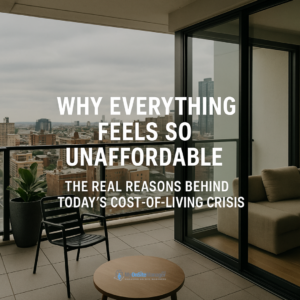Why does it feel like every year, life gets more expensive but paychecks don’t? From housing and groceries to rent and basic daily needs, Americans across the country are asking the same question: Why is everything unaffordable now?
A recent article from Daily Kos breaks down the historical numbers, the structural issues, and the economic choices that brought us here. What it reveals is a decades-long shift that dramatically widened the gap between the rich and everyone else.
Prices Skyrocketed Wages Did Not
One of the most shocking comparisons from the article highlights how drastically the economy has changed in the past 70 years.
-
In 1947, a modest home in a middle-class neighborhood cost around $7,990.
-
Today, the very same home is valued at nearly $700,000.
That’s an 8,650% price increase.
Now compare that with wages:
A postal worker’s salary went from about $6,176 per year in the 1960s to around $44,000 today just a 612% increase.
This means housing costs have grown more than ten times faster than wages.
And this pattern extends beyond housing:
-
Food prices
-
Transportation costs
-
Education
-
Utilities
-
Rent
-
Childcare
All have risen at levels completely detached from how quickly incomes grow.
What used to take one full-time job to afford now often requires two or even three.
Housing: From Achievable to Impossible
Back in the 1940s through 1970s, families could realistically save for a home, even on a single income.
But today?
Even dual-income households struggle just to save for a down payment.
Home values have exploded because of:
-
Limited housing supply
-
Investor and hedge-fund purchases
-
Zoning restrictions
-
Rising construction costs
-
Decades of demand outpacing new inventory
-
Wealth inequality pushing prices higher
The result: homeownership is no longer a middle-class guarantee it’s becoming a luxury.
The Decline of Unions = Lower Wages
The article points to a major turning point: the collapse of union membership.
-
In 1965, 1 in 3 private-sector workers was in a union.
-
Today, fewer than 6% are.
This decline directly weakened workers’ bargaining power and allowed corporations to prioritize profit margins over fair wages.
Without strong collective bargaining:
-
Raises stagnated
-
Benefits shrank
-
Job security declined
-
Working conditions worsened
-
The wealth gap ballooned
You can draw a straight line between the decline of unions and the rise of inequality.
Policy Choices Created This System Not “Bad Luck”
While inflation affects prices, that alone doesn’t explain why for decades, essential goods have risen dramatically faster than wages.
The article highlights several long-term policy choices that reshaped the economy:
1. Deregulation
Removing limits on financial institutions and corporations gave them disproportionate economic power.
2. Tax Cuts for the Wealthy
Multiple eras of tax policies shifted wealth upward, weakening public services and giving the richest Americans even more influence.
3. Weakening of Labor Protections
Policies reduced workers’ rights to organize and negotiate, leaving employees with far less leverage.
4. Corporate Consolidation
Many industries today are dominated by just a few companies from airlines to food brands to housing investors.
Less competition = higher prices.
5. Underfunded Social Safety Nets
While costs rose, programs supporting ordinary families did not keep pace, widening the burden on low- and middle-income households.
The economic pain people feel today is not accidental it is structural.
Everyday Evidence: Why Life Feels Harder
You don’t need charts to understand the crisis daily life tells the story:
-
A slice of pizza that once cost $1 now costs $4–7
-
Rent that was $500 is now $2,500+
-
A starter home that cost $80,000 in the 1980s is now $500,000–$700,000
-
Public college tuition that cost $1,000/year is now $10,000–$25,000/year
-
Gas prices swing wildly with global instability
Yet the average worker’s paycheck has barely moved when adjusted for inflation.
This explains why so many feel like they’re working harder but falling behind.
The Big Picture: A System Built for the Few
According to the article, wealth inequality has reached historic levels with corporate CEOs earning hundreds of times more than their workers.
Meanwhile:
-
Housing affordability is at its worst level in over 40 years
-
Young adults are delaying marriage, children, and homeownership
-
Millennials and Gen Z are on track to be financially worse off than previous generations
-
Debt burdens from credit cards to medical bills are climbing
The middle class is shrinking.
The working class is struggling.
And the wealthy have never been wealthier.
This is the affordability crisis in a nutshell.
Conclusion: Why This Matters
The article makes one thing clear:
The feeling that everything is unaffordable is not in your imagination it’s the result of decades of structural economic changes that prioritized profits over people.
Understanding the root causes is the first step toward demanding:
-
Fair wages
-
Affordable housing
-
Stronger worker protections
-
Better social support systems
-
Economic policies that promote equality, not exclusion
Until then, the cost-of-living crisis will continue to shape how Americans live, work, and plan their futures.
Source: https://www.dailykos.com/stories/2025/8/10/2337690/-Why-Everything-is-so-Unaffordable

